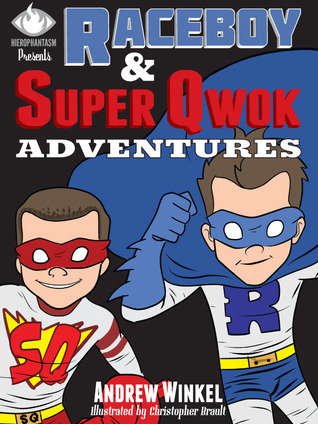Andrew Winkel's Blog, page 5
May 9, 2013
Reading from Memory
It’s an interesting fact about reading that sometimes—maybe even many times—our brains don’t actually read an entire word, but instead look at pieces of a word to jump to a conclusion about what that word is.
I read the book Double Star by Robert Heinlein with two of my seventh grade classes. The protagonist, Lorenzo, must impersonate a famous politician named “Bonforte.” But here’s the thing: I didn’t see the word as it was spelled. My eyes may have seen the word “Bonforte” but what my brain believed it read was the word “Bonaforte.” As I read aloud, I pronounced it “Bon-a-fort.” As I discussed the book’s vying political factions, I wrote the name on the board and spelled it “Bonaforte.” I drew connections between the name Bonaforte and Bonaparte.
Weeks later, I was absent for a period of two days and a substitute teacher corrected the kids during class, telling them the name wasn’t “Bonaforte,” but “Bonforte.” Even after I came back and the kids said, “The sub told us you were pronouncing it wrong,” I didn’t process what they were telling me. Then one day, as I sat down to read and looked at the book, I saw the word “Bonforte” where I expected to see “Bonaforte.”
“That’s weird,” I thought. “There was an ‘a’ in the middle of it before. I wonder if that’s a typo.” I looked for other instances of Bonforte and found them spelled without the ‘a.’ I thought, “Maybe they printed it wrong during the first half of the book.” I looked back and found that no, they had never written the name with an extra ‘a.’
Somehow, I had mis-read the word; afterwards I simply relied on my memory to fill in the word as I read.
Around the time I found myself attempting to explain how I had completely mis-read a name in front of two groups of seventh graders, NPR ran a news story on a scientific study titled, “Congenital Blindness Improves Semantic and Episodic Memory,” published in Behavioral Brain Research Vol. 244, May, 2013. While the gist of the study is none-too-surprising (i.e., those individuals blind since birth have a better ability to remember what they hear), there was a component to the results that intrigued me, and possibly related to the very reason I hadn’t read Bonaforte, er, I mean Bonforte correctly.
In a summary of the study, dailymail explained, “Research has shown we often recall words related to those we actually hear. For example, hearing the words chimney, cigar and fire could trigger a false memory of the word smoke.” The abstract for the study explains it with a bit more scientificospeak:
Participants study lists of words that are all semantically related to a lure that is not presented. Subsequently, participants frequently recall the missing lure. We found that congenitally blind participants have enhanced memory performance for recalling the presented words and reduced false memories for the lure.
What most intrigues me about the study is how our memories can leap to a conclusion that did not exist. The “missing lure”—an omitted concept that is thematically related to the presented words—becomes present in our memories because our brains intuit that it was present. This remarkable feature of the human brain appears to be a symptom of sighted people. Sight takes up a large part of the brain’s processing, and at the same time, sight relies to a great degree on memory. Rather than seeing the same thing time after time, the brain processes sights and fills in the details using memory.
This reminds me of a passage from the young adult novel, Thunder Cave by Roland Smith. It’s a book I read with numerous classes when I taught sixth grade. In the book, the main character, Jacob Lansa, is learning about “seeing” from a Maasai named Supeet:
“I don’t see anything,” I said.
“I will teach you to see,” he said. “It will take you some time to understand and perhaps you never will. That is up to you.”
“I’m willing to learn,” I said.
“Good,” Supeet said. “You must first stop looking at things the way you have looked at them in the past. You must see things with new eyes. The land has a language of its own and to see you must understand that language. There is a difference between seeing something the first time and seeing it the second time. For instance, when you come to a town that you have not seen before you pay close attention. The second time you go to that town you see less because you look at what is familiar.”
I hadn’t thought about this before, but what he was saying was true. The train from New York City to Poughkeepsie passed through many towns. the first time I made the trip with my parents I paid close attention. I’d look at buildings and houses, wondering what was going on inside them. The second and third trips, I paid less attention to what was passing by. On the last trip to see Taw I had barely glanced out the window.
“I think I understand,” I said.
Supeet continued. “Each time you see something, no matter how familiar you are with it, try to see it as if it were new. Try to pick out what has changes since you saw it last. Nothing stays the same—it may look the same, but it is always different. The reason it looks the same is because you are looking at your memory of it—not at what it is.
Smith captures exactly the reliance of seeing on memory. The brain is basically lazy, or if you will, thrifty. It can expend energy to see, but when possible, it conserves the energy and fills in details by retrieving them from memory. In this way the brain is like an internet browser that loads data locally from a cache rather than waiting for the data to download over the internet. And this is why sighted readers are more likely to have imperfect memories about words they listen to: the brain of sighted people relies on memory.
But that’s not all the brain relies on. If you’ve ever had an e-mail account, chances are you’ve seen the received the following:
Aoccdrnig to a rscheearch at Cmabrigde Uinervtisy, it deosn’t mttaer in waht oredr the ltteers in a wrod are, the olny iprmoetnt tihng is taht the frist and lsat ltteer be at the rghit pclae. The rset can be a toatl mses and you can sitll raed it wouthit porbelm. Tihs is bcuseae the huamn mnid deos not raed ervey lteter by istlef, but the wrod as a wlohe.
You can find out a whole lot about this pseudo-study at http://www.mrc-cbu.cam.ac.uk/people/matt.davis/cmabridge/, but the one thing I take away from it is that scientists have a lot of theories about how the brain reads (for example, “they propose a model of word recognition in which each word is split in half since the information at the retina is split between the two hemispheres of the brain when we read”), but we still aren’t sure how it does what it does.
I remember visiting the Bristol Renaissance Faire one summer as a sixteen or seventeen year old. A group of us stood in the tent of a vendor, oohing and ahhing over the metal miniatures he had created. The entire Fellowship of the Ring sat before us on a plank table, cast in lead (or pewter or whatever the heck they make miniatures out of). The craftsman talked about Gandalf and Frodo and finally pointed out, “Striker.”
We knew what he meant, despite the heretical nature of his utterance: when he said “Striker” he really meant, “Strider.” But my good friend Jamie wasn’t going to let that sin go. His passion for accuracy was stronger than his common sense.
“Don’t you mean, ‘Strider’?” he asked.
The vendor looked up from whatever he was doing—polishing a spoon, casting a miniature, filing the edge of a deadly weapon—and he stared at Jamie for a silent moment in which each of us felt that perhaps correcting the guy whose work we had just been praising was probably overstepping the whole respect your elders admonition. His response held all the rigidity of a metal file: “You say it your way, I’ll say it mine,” he said.
Did he really read the entire Lord of the Rings with a character named “Striker”? If so, the connotations carried by that character are entirely different than those conveyed by “Strider.” As an eight year old I read The Voyage of the Dawn Treader, pronouncing the name “Eustace” as “Estes,” but that was pronunciation, and neither of those names in-and-of-themselves had meanings to me (except Estes was the name of a model rocket company). Contrast that with Striker versus Strider: Striker says, “I attack!” while Strider says, “I walk great lengths.”
To me, extended mis-readings of this sort are a side effect of the way our brain reads, which includes jumping to a conclusion about the word based on a variety of factors, such as the letters the brain takes the energy to process, the context of the words surrounding it, and our own expectations about what the word should be. Mis-reads of this type are typically caught and corrected (or never caught in the first place) individually, but in my case, I read publicly, which meant that I found this processing scotoma worth taking some time to write about here.
Have you ever mis-read a word and it became clear at a later instant, forcing you to reassess your reading? What was that experience like? Feel free to leave me a comment below.
February 21, 2013
Find the Word Count for Published Books
 You’ve written a book, and after typing it in Microsoft Word, you have accumulated a grand total of 95,000 words. Now the question is: how do you find published titles with word counts comparable to your book within its genre?
You’ve written a book, and after typing it in Microsoft Word, you have accumulated a grand total of 95,000 words. Now the question is: how do you find published titles with word counts comparable to your book within its genre?
I won’t call this technique a hack, but it is using a tool that was meant for a different purpose to get your answer. Check out AR Book Finder.
For those of you who have been out of the public school scene for a while, the idea of the Accelerated Reader (AR) program by Renaissance Learning is likely unfamiliar. Basically, Renaissance Learning processes the text from each book using a top secret formula, then assigns a point value to the book. Alexander and the Terrible, Horrible, No Good, Very Bad Day by Judith Viorst is valued at .5 points; Atlas Shrugged by Ayn Rand is 102 points. Pretty much everything else falls between (except War and Peace, but then, it is Tolstoy). School-aged children read books, then take multiple choice tests over the books to accumulate points. The idea is the encourage independent reading by providing a virtually unlimited selection of book choices (the company claims more than 150,000 quizzes are available).
The first time you visit www.arbookfind.com, the site will ask whether you are a student, parent, teacher, or librarian. Your choice doesn’t matter other than to Renaissance Learning as they calculate what specific population is utilizing the site.
The main landing page is the basic search page. For more advanced options select the Advanced Search tab (more on the Advanced Search in a bit).
Go ahead and pick your favorite childhood book to search so you can see an example of a book record. The search results will be based on relevance and will have limited meta-data displayed. For most of the company’s primary users (K-12 students and their teachers), the search results contain as much information as they will ever need. Kids care about the points and to a lesser extent, the book level and the quiz number. Everything else is hieroglyphics to them, or the printed equivalent of the speech of every adult from the Charlie Brown cartoon universe (“Waah Waah Waah Waah Waah…”).
For our purposes, it’s the main book record that actually has the word count, so click on your top result to see the full details. The data that was previewed in the basic search results is expanded to include the following:
Word Count. The number sits in the middle of the meta-data immediately beneath rating.
ATOS Book Level. This is the reading level of the book; the first number represents the grade level, and the second number represents the month. Thus Atlas Shrugged should be readable for an eighth grade student in his or her second month of school.
At the bottom of the record is a list of published editions of the title including publisher, ISBN, year published, and page count. The list is not necessarily an exhaustive list, so don’t get too freaked out when your specific edition of The Neverending Story by Michael Ende isn’t displayed.
Advanced Search Tip: Search by ISBN
The Advanced Search page has a box to input a valid ISBN. As long as the book has been connected to the quiz, the result will pop up. This can be very handy if you happen to have a barcode scanner, as you can simply scan the book ISBN barcode to return a result. It’s also handy if you don’t have a barcode scanner because you can type the number from the back of the book or from the title page of the book to search for a specific item.
If the book is not in the database by ISBN, don’t give up hope (see note above about The Neverending Story), especially for a title that has been issued by many companies or in many editions. Unlike other sites that attempt to collect every book ever printed, AR’s only goal is to connect kids with quizzes. Those quizzes are built around book titles, not book editions. Thus there may have been more than twenty translations of Tolstoy but only one has actually been linked to a quiz (and oddly enough, the translator is NOT mentioned in the book record). This can create a challenge when trying to find some titles that have been adapted or abridged. Take Les Miserables, for example. Hugo’s behemoth weighs in at a hearty 105 points in its full, unabridged edition. But there’s also a 12,350 word adaptation that is worth only 2 points.
For those of you wondering about the book ratings/stars… After any reader finishes taking the test, he or she is asked to rate the book with the reminder that the rating will have no affect on the quiz score. Presumably those ratings contribute to the stars displayed with each book record.
If you are attempting to calculate your own book or reading level, you can see a previous post of mine that profiles Supermagnus software’s Word Counter program.
Does this help you? Or do you have a useful tip to share? I’d love to hear your comments.
Shakespearean Sonnet Maker
Here is a tool that I created to help write sonnets. I do not use it as a stand-alone assignment (i.e., I do not say, “Here, seventh graders, write a sonnet.”). Rather this comes at the end of a month-long period of analyzing every single poem in our textbook, listening to poets online, examining song lyrics, and even using this same form to dissect one of Shakespeare’s over 150 sonnets and then present it to the class (memorized, of course!).
The following is a PDF version of a Word document. I’m sharing it as a PDF so that the document will print correctly without dealing with changing font faces or table heights. It should be workable for anyone as is, but if you would like the Word document, drop me a message.
January 8, 2013
Ruminations on Writing Part Two: The Aggregate Self
Since publishing my last post, I have torn my file cabinets apart. I was looking for a specific journal entry that I remembered writing. I could not find it in my laptop, in my external hard drive, in my various half-filled composition books that date back to 1995. Finally, after nearly a week, I found loose steno pages in a hanging folder titled “Essays/Thoughts.” I don’t have the exact date this would have been composed, but Roland Smith visited Bradley Central somewhere around my fourth year teaching, which would have been around eight years ago. Without digging through school yearbooks (which I don’t have access to at home), I would estimate this entry as having been written in November 2004.
Each book I read inevitably brings me to the same conclusion: “I couldn’t have written that — it’s too good.” This disheartening sentiment serves as a real downer when trying to buoy myself into believing my writings are equal to the task of publication. While listening to young adult author Roland Smith discuss his writing process at an assembly yesterday, I had a realization. A novel (actually, most writing from short story to epic) is written not in an instant, but over an extended period of time. I am, at every instant, a newly realized being who is completely unique from the self of a moment ago. At times I have access to stores of words which will later fall behind the boxes in my mind to be come covered with slimy growth. Perhaps an image from a discussion I listened to on Extension 720 is rioting between my ears and later the same image is deflated and pallid. Simply through life I change moment by moment, and it is this dynamic aggregate of me who is the true author of my writings. Not just the self who exists in this moment, but the accumulation of selves working to construct the words which finally take form. Thus a novel is, in a sense, able to be greater than the man who writes it because that man experiences so much more than a single man’s experiences through the building of the novel. When I am feeling inadequate as I compare myself against a novel, I am actually looking at myself in this moment and comparing me against the aggregate author who is the sum of all his parts and thus vastly wiser than I am.
December 30, 2012
Ruminations on Writing
Back in August, a writing friend contacted me with the admission that over the last few months he had been suffering from creative paralysis. He explained, “I was mired in self-pity by lack of response and under-appreciation of what I was doing by the populous. I put the brakes on everything and climbed into the ditch.”
To me, the most telling part of this statement was the prepositional phrase, “by the populous.” My friend didn’t hate his most recent project. He wasn’t frustrated that his work wasn’t turning out the way he had originally envisioned it. It wasn’t criticism that sent him into a creative tailspin. Instead, it was the the feeling that despite all of the energy he had poured into his writing, giving his writing to the world was tantamount to shouting as loudly as he could to a room full of people who ignored him.
On this blog in the past I have facetiously referred to this phenomenon when I addressed my readers as “both of you.” The inference is that my words, pounded on plastic and visible on pixels, will reach a net audience of two. (Note the dual meanings of net…just another example of why I deserve to have more than two readers.)
Writers write from an implicit assumption that there will be at least one reader. The author writes, and the reader reads. Otherwise writing is the tree of the proverbial forest: if you write but no one reads it, do your words make a sound?
The construction of a poem or a story or a book can require an investment of time. For Raceboy and Super Qwok Adventures, I spent as much time in the post-writing process of editing and layout as I spent on the composition process: it was truly like working a third job. I realized that even if I were to add up the total amount of time my readers spend reading my words, the sum of their time will still not be likely to exceed the amount of time I personally invested in bringing that work to life. There is not a word or term in English to identify the point where the invested time of the reader exceeds the invested time of the content creator, but it is likely that a great many works do not ever break even.
When my friend faced this unarticulated realization about his total invested time versus the total time his readers had invested reading his work, he recognized that he had worked hard for a very small — maybe even negligible — return on his investment. And that sent him into a depression.
For most of my life I imagined a writer’s words to be chiseled in the stones of time, etched for eternity to be read, pondered, appreciated, like constellations in the sky. It’s only been over the last six years as I’ve worked at the library that I’ve realized the impermanence of a writer’s words. The books that fill the library shelves live only while they have readers. I faced an entire shelf of Frank Slaughter’s books, none of which had been checked out in the last thirty years, and finally purged them to free shelf space. Slaughter sold millions of books over his career, but that career ranged from the 1940s to the 1980s. By 2010, they were ignored, possibly irrelevant, and essentially dead.
In the January 2013 issue of Wired, Steven Levy interviewed Tim O’Reilly. When Levy asked, “What is the future of books?” O’Reilly explained, “…I don’t really give a shit if literary novels go away. They’re an elitist pursuit. And they’re relatively recent. The most popular author in the 1850s in the US wasn’t Herman Melville writing Moby-Dick, you know, or Nathaniel Hawthonre writing The House of Seven Gables. It was Henry Wadsworth Longfellow writing long narrative poems that were meant to be read aloud. So the novel as we know it today is only a 200-year-old construct. And now we’re getting new forms of entertainment, new forms of popular culture.”
O’Reilly doesn’t use the p-word, but he’s referring to our paradigms about novels when he answers the question. We expect that our assumptions about novels are eternal and unchanging much like those constellations.
But the thing is, even the constellations won’t last forever. It’s a theme that came out in a different article in the same issue of Wired on an entirely different topic. Andrew Zolli explained, “The sustainability movement has been around for four decades. I think it may have outlived its usefulness. When they tell you they want to conserve the rain forest, save the pandas, and so forth, the message is always the same: They want to maintain a beautiful little picture of stasis. But we need to recognize that stasis isn’t realistic” (pg. 22).
We are trapped in a chronological progression like beads of a pearl necklace, a progression of experienced present moments, and our expectations from one pearl to the next pearl are that the pearls are the same, have always been the same, and will always be the same. Because each pearl has been round and white, we assume that every pearl is round and white, that every necklace is made from pearls. But what is a pearl? The form of the writing may evolve, the shape of the pearl may change, could become a bead, a chain, a rope, but it will always need to have a reader.
I write for the reader who I hope someday will read my words, invest his or her time to ponder what I’ve written; I write for the someday when the sum total of the time that my readers spend reading my words adds to a greater total than the time I’ve spent writing them. I write for the possible future that I hope exists despite the likely obscurity of oblivion that is inevitable, even for the stars. In the face of entropy, I write for those moments when a reader will read my words, when a connection will take place. Andy Warhol explained, “In the future everyone will be world-famous for fifteen minutes.” I write for that fifteen minutes, though it may already have happened, or it may never happen. I write for the unknown, unknowable listeners who hear the tree of my writing in the forest, who hear my shouts in a cacophonous room, who see my words glowing in a shape in the night-time sky.
October 31, 2012
Nanowrimo Eve
Well, it’s here. The night before another Nanowrimo.
I have completed Nanowrimo twice before (2009 and 2010). During 2011 I was too busy working on layout and final work on Raceboy and Super Qwok Adventures to spend the time writing. This year, though, I have decided that I will take the plunge and use Nanowrimo as an opportunity to draft a follow-up book, Flowergirl and Dr. Destructo Adventures. I really don’t expect to hit the 50,000 word mark because, well, to be honest, I have too much going on. I will try to post updates on my word counts to share my progress, however, just so you can see how anemic my attempt turns out to be.
October 5, 2012
Notice of Confidentiality
Last week I decided that I needed a notice of confidentiality to add to my emails at school. Because the internet has become the go-to tool for such things, I did a quick Google search. I was disappointed with the results. Muddling through the too-serious and too-ridiculous or too-off-topic, I realized it would be faster to simply craft my own. Here, then, is my own notice of confidentiality. It has never been evaluated by a lawyer (otherwise it would be longer), and is certain to be legally impotent. It does, however, remind us that sometimes we take ourselves too seriously.
Notice of Confidentiality: The information contained in this message is intended for those addressees so named by the originating sender. The contents of this message should not be disseminated, distributed, copied, converted to audio files through mechanical transcoding, read aloud in places where you can be overheard (even with a great British accent it’s still a no-no), translated to any foreign languages (including dead languages like Latin, or dying languages such as Yuchi, Djawi, or Siletz Dee-ni) or constructed languages (yes, Esperanto and Sylvan are out), or Braille, or Sign (including ASL, baseball coach signs, or the middle finger). In short, this message is confidential, which shall herein be defined as none of your business (unless you are an addressee so named which was explained in the first sentence, but we’re not going over that again or this disclaimer will turn into John Jacob Jingleheimer Schmidt).
If it isn’t meant for you, contact the sender immediately to inform him, and delete this message.
By the way, I am not responsible for what you do with this information. If you print it out, roll it into a ball, and try to swallow it without water, choke, then are barely saved the hasty application of the Heimlich maneuver, it’s not my responsibility. If you see it on your screen, but the pixels go all wacky and flash really fast, and the image zings through your eyes into some forgotten crevice in your brain that spirals you into an epileptic seizure, it’s not my fault. If you use this in an e-mail and your boss calls you on the carpet because the company disclaimer should actually have two pages more than the iTunes legal notice, I’m not responsible for your choices. In other words, use at your own risk. After all, you found this on the internet.
September 4, 2012
Replacing a Rotted Window Sill and Broken Concrete Ledge in a Brick Facade House (Whew!)
This post chronicles how I’m going about solving some interconnected problems on my house. Here is the gist:
The poured concrete window ledges on my 1958 brick facade home have all deteriorated and begun to split and fall off, causing an eyesore as well occasional water infiltration.
The wood window sills from the original construction windows have rotted and need to be replaced, possibly adding to the water infiltration noted above.
Replacement windows were installed before we purchased the house, and although they were probably a really cheap window, they are still in good enough shape to keep and reuse, especially given the number of windows I would need to replace.
New window ledges available from the local brick supplier are only half the height of the original concrete ledges, which means that I need an additional course of bricks to fill in the space. Unfortunately, the bricks used to build my house are (predictably) unavailable in any quantity.
I actually have a total of ten windows like this to deal with. I began with the two in our extra bedroom, which we are renovating into an office. I completed the first window using trial and error, then documented the steps I followed in the second window so I could repeat the steps next summer. (Don’t tell my wife I just wrote “next summer.” She is still under the hifalutin impression that her “amazing” husband will have three more windows done by winter.)
This project is unlike anything I have been able to find online. There are lots of resources to replace windows or replace rotted sills, but no step-by-step instructions that will handle all of the problems I’m dealing with. The result is my own solution, a solution I came up with, and a solution that I think works. The choice of a contrasting brick to fill the extra space was an experiment, and while I would prefer to keep the original brick, I think that after all of the window ledges are complete the overall look will be pretty good. Keep in mind as you look at these images that I’m not a mason or a carpenter; I’m just a do-it-yourself homeowner. I don’t pretend to endorse my methods as being advisable in your particular situation, so please consult a professional or, even better, simply take personal responsibility for making the choice to try to replicate something I did when I’m telling you point blank I’m not sure this is right.
Here is a link to the images in a video format:
The images themselves can be previewed in the following gallery:





































July 8, 2012
Daily Journal Reviews Raceboy and Super Qwok Adventures and we have Fun at Clifton Fun Days!
I was snapping pictures of the Clifton Fun Days talent show when I looked over at the table Chris and I had set up for the Clifton Fun Days. He was sitting behind copies of the book, Raceboy and Super Qwok Adventures, which we were selling as a part of the local event. And he was intently reading The Kankakee Daily Journal. I thought that was unusual, because Chris hadn’t shown up with a copy of The Daily Journal. As the talent show wrapped up and I got back to the booth, Chris smiled and waved the paper. “We got a review! What great timing!” And here it is:
Since I not only wrote the book but also published it, there are a number of comments that Phil pointed out that it was satisfying to see. I know Chris likes to joke that I drone on with discussions about fontfaces, but I really spent a lot of time looking at different fontfaces to find the perfect type for the copy of this book. To have Phil acknowledge that it is “set in large type for easy reading” means that all that work was really worth the effort and paid off in readability. My goal was that the font would not be a barrier to the reading of the book, but would invite reading.
Value was also important to me. I am thrifty by nature, and wanted a book with a price that consumers could consider a good value. Angelo recognized that the book was priced fairly: “at the price, it is a lot of reading for your dollar.”
“By midbook, Winkel gets a bit more clever,” he writes. In my own read-through of the proof copy I felt that the book took off around page 150. The characters have matured, the villains have been introduced, and the stories get longer and more elaborate.
To me, the greatest compliment is this: “It’s certainly unique–much longer and thicker than any book in the modern era. It is sort of a holdover from earlier times, more like ‘Treasure Island’ than ‘Dr. Seuss.’”
One minor correction I should add is that Angelo listed my sons as Andrew and Bryan, but it’s really Alex and Bryan. Bryan was supposed to be Andrew, but that’s a story for another time (Andrew Edward, which my aunt pointed out could be shortened to Drew Ed, or Druid, and we miffed it by going with Bryan; but he really is a Bryan, so that’s okay; I just have to wait for grandkids to have one named after me).
The result of the review was that we had at least two people who walked by our table at the Fun Days and said, “Hey! I saw that in the newspaper!” One family bought a copy of the book after seeing the review, as though fortune had aligned to show them the book and the place to purchase it all on the same day.
A highlight of our day in the heat was having a young reader tell me that the book was awesome. I didn’t get exact quotes from the boy, or even his name, but he looked to be about seven. I asked him which story was his favorite, and he replied that he liked them all. And before he continued on his way with his family, he told me that he reads it a lot when he’s in the bathroom.
June 5, 2012
Win Raceboy and Super Qwok Adventures!
.goodreadsGiveawayWidget { color: #555; font-family: georgia, serif; font-weight: normal; text-align: left; font-size: 14px;
font-style: normal; background: white; }
.goodreadsGiveawayWidget img { padding: 0 !important; margin: 0 !important; }
.goodreadsGiveawayWidget a { padding: 0 !important; margin: 0; color: #660; text-decoration: none; }
.goodreadsGiveawayWidget a:visted { color: #660; text-decoration: none; }
.goodreadsGiveawayWidget a:hover { color: #660; text-decoration: underline !important; }
.goodreadsGiveawayWidget p { margin: 0 0 .5em !important; padding: 0; }
.goodreadsGiveawayWidgetEnterLink { display: block; width: 150px; margin: 10px auto 0 !important; padding: 0px 5px !important;
text-align: center; line-height: 1.8em; color: #222; font-size: 14px; font-weight: bold;
border: 1px solid #6A6454; -moz-border-radius: 5px; -webkit-border-radius: 5px; font-family:arial,verdana,helvetica,sans-serif;
background-image:url(http://www.goodreads.com/images/layou... background-repeat: repeat-x; background-color:#BBB596;
outline: 0; white-space: nowrap;
}
.goodreadsGiveawayWidgetEnterLink:hover { background-image:url(http://www.goodreads.com/images/layou...
color: black; text-decoration: none; cursor: pointer;
}
Goodreads Book Giveaway

Raceboy & Super Qwok Adventures
by Andrew Winkel
Giveaway ends July 01, 2012.
See the giveaway details
at Goodreads.






